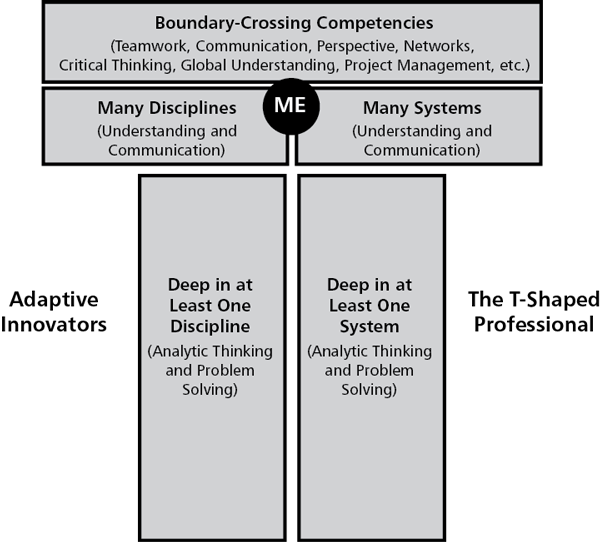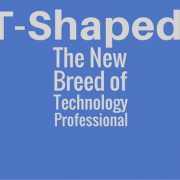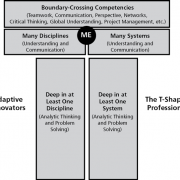APM & SEE EXECUTIVE UPDATE VOL. 17, NO. 8
Regardless of whether your goal is to innovate around a product, service, or business opportunity, you get good insights by having an observant and empathetic view of the world. You can’t just stand in your own shoes; you’ve got to be able to stand in the shoes of others.
—Tim Brown, CEO, IDEO
Over the last decade, we have seen an explosion of IT innovations, including cloud computing, big data, analytics, social, mobile, the Internet of Things (IoT), and other innovations that are making our world more interconnected and complex.
In the next decade, this convergence of information and communications technologies (ICTs) will mature into technology platforms that provide service solutions, around which there will be more established value-generating ecosystems (e.g., Android and iOS ecosystems) with lots of process, organizational, policy, and business model innovations. These changes will drive new opportunities for new services, giving rise to myriad innovative applications and customer-focused service ecosystems in and across diverse industries, such as healthcare, transportation, finance, energy, and others (e.g., evidence-based medicine enabled by IBM Watson Developer Cloud for healthcare; Johnson Controls’s Panoptix app marketplace for smart energy).
These innovations will lead to tremendous change in the way we work and co-create value in and around these diverse service ecosystems. Technology professionals need to understand and manage complexity and to navigate the changing nature of this new value co-creation paradigm, which requires them to be more collaborative and open.
Workforce 2020-2025: What Skills Are Needed to Survive and Thrive?
Discover the critical skills and training that business technology professionals will need in the coming years. Receive your free copy of this Cutter IT Journal issue when you complete our special offer form.
To understand, manage, and thrive in this changing world, technology professionals must become more T-shaped. This means that to be an excellent service professional or a data scientist, one must also:
- Be a savvy entrepreneur
- Have high emotional intelligence; be inquisitive about people
- Develop an understanding of other disciplines, functions (even industry verticals), and systems
- Manage complexity
- Value diversity of experience, knowledge, geographic location, and ethnicity
In this Executive Update, we discuss why IT professionals must become more T-shaped, what it means to be more T-shaped, and how mid-career technology professionals need to continue to grow in their career in order to thrive in this rapidly changing world. We will also discuss how an executive understanding of this concept can be incorporated into business today to drive greater flexibility and value in the future.
The Future of Services
ICT capabilities are expanding exponentially. There is an abundance of computing, networking, and data analysis capability that most organizations have only started to understand. The trends mentioned above are coming together in ways that were unimaginable just a few years ago.
Businesses are gathering information from a wider range of sensors and integrating it with other sources to provide a contextual understanding of great depth and value. They no longer assume their business is self-sufficient and are embracing open business models. In order to address the needs of customers going forward, individual businesses are aggregating services together into ecosystems (sometimes made up of partners and competitors) to meet market needs. These advances in capabilities will have a direct effect on services, regardless of industry. The number of standalone companies that can compete globally is diminishing. New levels of understanding are only now being internalized, and advances in analytics and pattern recognition will be a catalyst to disruptive solutions in new areas.
Certainly, the current trend in wearables is supporting a growing number of applications in the quantified-self movement. Measurements of the human body’s condition have been possible for a long time (e.g., weight, heart rate, blood pressure). Now that the information ecosystem has caught up, the marketplace is both creating and demanding new levels of functionality almost daily, thereby generating new service industry possibilities. For example, it is possible to assess stress levels as people use their computers. This enables an assessment of the quality of a user interface design or a business process in real time. This more holistic view can influence how we interact with our systems and how they interact with us.
Of course, when you pull together information like this, there are myriad security and privacy implications for the consumer. As you understand who is doing what, when, and what else is going on at the same time, the veil of privacy that seems to apply to a unique transaction can be lifted. Consequently, organizations must reassess how information is collected, stored, and used. IT professionals will all need a sufficient level of security training and expertise going forward. These shifts in expectation will have a direct effect on those working in the service industry.
The ability to understand and act upon context using automation will shift the expectations and workload of knowledge workers as well as other service professionals. It will force them to focus on higher-value activities, leaving the mundane tasks for automation to act upon. This change will require professionals to reassess their skill sets and the ways they add value, leading them to broaden skills in some areas (soft skills like aural communication, leadership, and writing) and increase their depth in others (data science). This is coming at a time when many desire the curriculum in formal education to decrease soft skills training.
With data as the new precious resource, the areas where people focus the majority of their time within organizations will shift as well. Whereas in the past organizations may have been satisfied with understanding their portfolio of applications and how those applications add value, today understanding the portfolio of data and how it is used in the context of customer needs is going to increase in importance.
The adoption of this abundance of technical capability will require new, more flexible and dynamic skills. Understanding and operating on data at rest will no longer be sufficient. To drive latency out of an organization’s response, operating upon data in transit will become increasingly important. This will be taking some of the current software-defined networking capabilities to whole new levels of functionality.
In the 21st century, being able to focus employee attention as quickly and efficiently as possible on important issues will be a differentiator. Each of us gets 60 minutes in an hour that we can use, and organizations that understand how to use employee insight and capabilities more effectively will have an advantage. Automating the events that are well understood and minimizing disruptions will be important. Those individuals that have not only depth, but also the breadth of skills and knowledge to take advantage of the improved information flow will stand out.
All these changes are demanding a new breed of IT professional: the T-shaped IT professional.
The T-Shaped IT Professional
T-shaped professionals (see Figure 1) are in demand and on the rise. They typically have depth of skill in at least one discipline (computer science, mechanical engineering, statistics, mathematics, etc.) and one service system (ICT, healthcare, financials, etc.), which together represent the vertical leg of the T. They are also broad in that they can collaborate effectively with others who are deep in other areas to innovate, co-create, and solve today’s complex problems.
The horizontal bar includes competencies such as project management, organizational design, communication, critical thinking, teamwork, networks, commitment to lifelong learning, and, above all, empathy. T-shaped people have a keen ability to put themselves in the shoes of others, such as customers and partners, and see situations from their perspective. This enables them to understand their challenges first and spot opportunities to co-create in a way that results in sustainable competitive advantage.

Figure 1 — T-shape explained.

According to research by Nicholas Donofrio et al. (“Evolution of Medical Education and Practice: Research-Driven T-Shaped Professionals”), the more T-shaped an individual becomes, the more his or her perceived value to the organization increases. In order to be a T-shaped person, an individual needs to earn T-shaped knowledge. “T-shaped knowledge” is knowledge that characterizes a professional’s ability to dynamically combine knowledge assets by integrating and reconfiguring internal and external competences in order to address the requirements of a rapidly changing environment.
While becoming more T-shaped is important to professionals from all disciplines, this will be especially true for IT professionals, for whom the pace of change continues to accelerate. In fact, the earliest known citation to T-shaped professionals was in reference to IT professionals:
The hunt for a new breed of computer manager is on. The British Computer Society, in a controversial report … described the quarry as a “hybrid” manager who would combine business expertise with IT skills. The hybrid manager, it said, would be distinguished by his or her ability to relate to “the broad picture” and to people, understanding their motivation and aspirations; he or she would also be energetic, intuitive, a good listener, and (cryptically) would have “an unusual set of interests.”
— David Guest (“The Hunt Is On for the Renaissance Man of Computing.”
The Independent, 17 September 1991).
Globalization is in full swing; unprecedented opportunities are being made possible every day at the confluence of big data, analytics, the IoT, mobile computing, and social media; and cognitive computing enabled by complex pattern recognition is a growing trend. So while the T-shaped concept has been around for more than two decades already, it is now more important than ever for IT professionals to assess how they are creating value and to focus on higher-impact activities. Several professional organizations have therefore begun developing certification programs as well as assessment tools and conferences to promote T-shaped development for service professionals across the globe.
As universities prepare next-generation IT undergraduate and graduate curricula, these redesigned programs of study are including more T-shaped learning and “Open Innovation” team projects that focus on real-world challenges, real-world data, real-world tools, and real-world coaches. These courses allow students to make their initial, faltering steps in a safe environment. Olin College of Engineering, for example, has embraced the notion of project work from day one.
Imagine how demotivating it would be for musicians to spend years mastering music theory before they could touch an instrument and perform — yet that is exactly how education in some areas is constructed. A holistic approach that allows students to exercise the skills they are being taught as well as the skills needed to be successful once they enter the working world is clearly needed.
What Does All This Mean?
Many mid-career professionals and IT executives are already quite T-shaped, as measured by their ability to work on teams that are multidisciplinary, multisector, and multicultural. They may also demonstrate empathy and the desire to learn more about business models, organizational change, incentive designs, and other factors that influence the successful deployment of new technologies and services in the enterprise.
One challenge for these IT professionals who are already T-shaped is what Geoffrey Moore calls the “pull of the past,” where old habits persist despite market forces that require new habits to propel the enterprise into the future. The T-shaped IT professional can overcome these old habits by asking, “What does the world really want from us? ... What opportunities unfold if [we] put [ourselves] in service to and take [our] direction from the people in the world [we] most want to succeed (customers, suppliers, partners) and who most want [us] to succeed?”
Another challenge for IT professionals is to shift from a waterfall, product-dominant, technology-centric approach to more agile, service-dominant, customer-centric, incrementally validated interaction. Service-dominant logic provides a set of foundational premises for a worldview in which customers play a critical role in the co-creation of value. Customer co-creation of value means that IT professionals are increasingly building platforms that are open and allow crowdsourcing, as well as building cognitive systems (big data analytics) that include machine-learning components. Therefore, the service-dominant IT professional must understand Open Services Innovation. T-shaped skills are crucial to effectively implementing this more dynamic approach.
Open Services Innovation is a collaborative framework developed by organizational theorist Henry Chesbrough that enables firms to integrate and reconfigure internal as well as external capabilities in an adaptive fashion to address the requirements of a rapidly changing environment. Using this framework, you approach your business as an open services business (even a product is a platform for service) so as to avoid rapid commoditization of innovation. You include customers in the design and development process in order to co-create the experiences they will value and reward. You use Open Innovation (a concept also popularized by Chesbrough) to turn your business into a platform others can use to innovate and to create a sustainable ecosystem. Finally, you transform your business model based on innovations you are enabling in this ecosystem. T-shaped professionals are best suited to create and leverage Open Services Innovation models due to their inherent understanding of customers, their collaborative approach, their understanding of business, and their sense of where opportunities lie that lend themselves to Open Innovation.
Over time, with more T-shaped individuals in the organization, IT executives can successfully drive business transformation efforts that shift the role of IT from the cost centers of the past, which were designed for enterprise efficiency, to the profit centers of the 21st century, which are designed to drive revenue and growth and differentiate the organization in the marketplace.
Conclusion
To sum up, T-shaped development is especially important for IT professionals in a converging world because:
- The accelerating rate at which new IT knowledge is being created means that IT professionals must be more adaptive, with “boundary-spanning” abilities.
- The nature of IT project work today often requires IT professionals to work on multidisciplinary, multisector, and multicultural teams.
- The changing role of IT in the enterprise will require IT professionals with business and organizational knowledge in addition to technology expertise.
- Increasingly, IT innovation means providing an expanded role for customers and partners to co-create value on platforms, so Open Services Innovation initiatives are on the rise.
T-shaped IT professionals working on teams with other T-shaped professionals will build tomorrow’s smart service systems.




